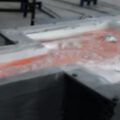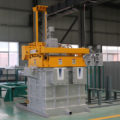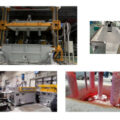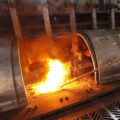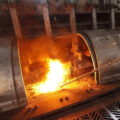The refining effect of molten aluminum has an important influence on the formation of pores, shrinkage cavities and inclusions, and directly affects the physical and mechanical properties of aluminum alloy castings. Without high-quality molten aluminum, even if the subsequent processing is advanced, the defects will always exist in the product once they occur, and high-quality castings are difficult to obtain. Therefore, we must pay attention to the gas and inclusions in the molten aluminum, and take measures to remove the gas and inclusions in the molten aluminum.
Gas and inclusions in molten aluminum
The gas in molten aluminum is mainly hydrogen (about 80%-90%), followed by nitrogen, oxygen, and carbon monoxide. Hydrogen is almost insoluble in solid aluminum, but has a large solubility in liquid. The solubility of hydrogen on the solid phase line is 0.65mL and 0.034mL per 100g aluminum liquid (hydrogen under the condition of 0.1MPa), that is, the difference in solubility of hydrogen in the solid-liquid phase is 19.1 times, and per 100g molten aluminum The normal hydrogen content is 0.1-0.4mL. Due to the difference in solubility, hydrogen tends to escape from the melt. When the hydrogen pressure is greater than the surface tension and hydrostatic pressure, bubbles are formed, which in turn creates pinholes in the casting.
Therefore, in the purification of aluminum alloy melt, the main problem is that the hydrogen content of aluminum alloy is high, and the existing methods cannot meet the production requirements of high-quality aluminum alloy castings. Usually, the hydrogen content per 100g aluminum can basically meet the production requirements when the hydrogen content is 0.1-0.2mL, and the hydrogen content per 100g aluminum for special requirements (such as aviation castings) should be less than 0.06mL.
Inclusions are any solids and substances other than liquids above the liquidus. Common non-metallic impurities in molten aluminum include oxides, nitrides, carbides, borides, etc., mostly in the form of particles, with a typical particle size in the range of 1-30μm.
Except for the charge, it is mainly the product of the chemical reaction in the melting process. The thickness of the oxide film on the aluminum surface is 2-10μm, and it increases to 200μm when it is close to the melting point. The oxide film on the liquid surface is not only thicker, but also the structure has changed; the side facing the molten aluminum is dense and has a protective effect on the molten aluminum. The outside of the molten aluminum is loose, with small holes with a diameter of 5-10μm inside and filled with hydrogen, air, and water vapor. If the liquid film is stirred into the molten aluminum, it will increase impurities and gas.
In addition, some undesirable primary intermetallic compounds will appear in high alloy melts, such as aluminum zirconium, aluminum titanium, etc., iron-containing aluminum alloys will also form iron-rich aluminum-iron phases, aluminum-silicon-iron, and aluminum-silicon The iron phase is a needle-like compound that seriously damages the aluminum matrix and affects the mechanical properties.
There is a strong interaction between inclusions in aluminum alloy and gas. The hydrogen content in molten aluminum is greatly affected by inclusions. When the inclusion content is 0.002% and 0.02%, the corresponding hydrogen content is 0.2mL/100gAl and 0.35 mL/100gAl. In the case of the same hydrogen content, the higher the inclusion content, the higher the pinhole rate; on the contrary, when the aluminum liquid contains very low impurities, the hydrogen content is also very low; even if the hydrogen is artificially injected, it will automatically precipitate, Quickly restored to the original content.
Even if a small amount of inclusions are present, the critical concentration value for the formation of pores can be significantly reduced. On the other hand, when there is no inclusion (or the inclusion content is very low), the critical hydrogen concentration to form pores can reach 0.3mL/100gAl. Therefore, it is equally important to remove impurity and gas at the same time. No matter which refining method is used, the effects of degassing and impurity removal are often both, but each has its own focus.

Current status of aluminum alloy melt purification technology
At present, the comprehensive treatment of purification and grain refinement of liquid aluminum is the basic problem for obtaining high-quality aluminum alloy. According to the different production links, the purification treatment of molten aluminum can be divided into treatment in the furnace and treatment outside the furnace. The aluminum alloy furnace treatment can be divided into adsorption purification technology and non-adsorption purification technology according to the purification mechanism.
The purification of adsorption method mainly relies on the effect of adsorbing oxidized inclusions produced by the refining agent, while removing oxidized inclusions and the hydrogen attached to the surface to achieve the purpose of purifying molten aluminum. Non-adsorption purification relies on other physical and chemical effects to achieve the purpose of purifying molten aluminum.
The adsorption refining purification effect of molten aluminum only occurs on the adsorption interface, and the purification effect of the non-adsorption method acts on the entire aluminum liquid at the same time. The adsorption method mainly includes inert gas purging, active gas purging, mixed gas purging, chlorine salt (hexachloroethane) purification, non-toxic refining agent purification, solvent purification, etc.; non-adsorption method, mainly vacuum purification treatment method (Static vacuum treatment, dynamic vacuum treatment), ultrasonic purification treatment method, electromagnetic purification treatment method, pressure crystallization method, rare earth element hydrogen fixation method, etc.
When refining with chlorine in the adsorption purification treatment technology, chlorine and liquid aluminum generate aluminum trichloride, and aluminum trichloride and hydrogen generate hydrogen chloride, which has both physical and chemical effects. The refining effect is obvious, but it pollutes the environment and is harmful to the human body. Later, inert gas (nitrogen and argon) was used for refining, and even 99.999% inert gas was used, but the effect was not good and the cost was increased.
Various methods are used to improve the refining process, but the effect of chlorine refining is always not achieved. In recent years, foreign countries have adopted mixed gas refining, that is, inert gas plus active gas, which can strengthen the hydrogen removal effect of the melt and help remove the inclusions in the aluminum alloy, and form dry slag on the surface of the aluminum alloy melt. Refining effect. Moreover, the mixing amount of chlorine can be conveniently controlled, and the impact on the environment is not large.
In the adsorption purification treatment technology, through process innovation and process transformation, many practical aluminum liquid treatment methods have been produced: such as inert gas rotating degassing, foam ceramic filtration, powder spraying treatment, and the combined use of rotating degassing and powder spraying treatment, etc. Among the non-adsorption purification treatment technologies, the rare earth element hydrogen fixation method is also one of the future development directions.




